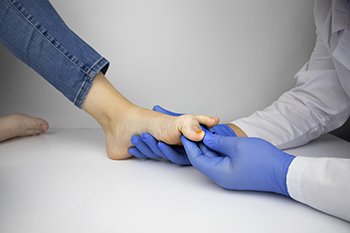
Stress fractures are common injuries to the bones of the legs and feet, resulting from repetitive stress rather than sudden injury. These hairline cracks in the bone affect athletes, including runners, basketball players, or dancers. Pain from stress fractures is particularly felt during weight-bearing activities and direct pressure on the bone. They may be difficult to diagnose as the pain often subsides when activity stops. Because they do not always show up on an X-ray, further diagnostic tests, like CT or MRI scans may be needed. Left untreated, stress fractures in the feet or ankles can worsen, leading to more severe complications. Seeking timely medical attention from a podiatrist is essential for proper diagnosis and treatment tailored to individual needs. This facilitates pain relief, promotes healing, and prevents further damage. If you are experiencing symptoms suggestive of a stress fracture, it is suggested that you schedule an appointment with a podiatrist.
Activities where too much pressure is put on the feet can cause stress fractures. To learn more, contact one of our podiatrists from Graff Foot, Ankle and Wound Care. Our doctors can provide the care you need to keep your pain free and on your feet.
Dealing with Stress Fractures of the Foot and Ankle
Stress fractures occur in the foot and ankle when muscles in these areas weaken from too much or too little use. The feet and ankles then lose support when walking or running from the impact of the ground. Since there is no protection, the bones receive the full impact of each step. Stress on the feet can cause cracks to form in the bones, thus creating stress fractures.
What Are Stress Fractures?
Stress fractures occur frequently in individuals whose daily activities cause great impact on the feet and ankles. Stress factors are most common among:
- Runners
- People affected with Osteoporosis
- Tennis or basketball players
- Gymnasts
- High impact workouts
Symptoms
Pain from the fractures occur in the area of the fractures and can be constant or intermittent. It will often cause sharp or dull pain with swelling and tenderness. Engaging in any kind of activity which involves high impact will aggravate pain.
If you have any questions please feel free to contact our offices located in Plano, Dallas, Prosper, Allen, Irving, Garland, Frisco, and Coppell, TX . We offer the newest diagnostic and treatment technologies for all your foot and ankle needs.
 Selecting the right running shoe involves considering several factors to ensure optimal support, comfort, and injury prevention. The first is your foot type, such as flat feet, high arches, or normal arches. You may also have a certain gait pattern, which is how your foot moves when you walk or run. Some people have feet that roll to the outside or inside, and certain shoes address this. Another consideration in choosing running shoes is the type of running you'll be doing. The right shoe should provide adequate cushioning to absorb impact, support tailored to your foot's arch type, and a comfortable fit for natural foot movement. Podiatrists can help you to understand all of the factors in this selection process. With their expertise in foot mechanics and conditions, podiatrists can perform a comprehensive evaluation of your feet to recommend shoes that match your needs. For example, they can conduct a gait analysis to recommend the right shoes for the way you walk. They can also identify any underlying issues that might affect your choice, such as pronation concerns or the need for custom orthotics. If you are in the market for new running shoes, it is suggested that you consult a podiatrist to find shoes that will maintain your foot health and optimize your running performance.
Selecting the right running shoe involves considering several factors to ensure optimal support, comfort, and injury prevention. The first is your foot type, such as flat feet, high arches, or normal arches. You may also have a certain gait pattern, which is how your foot moves when you walk or run. Some people have feet that roll to the outside or inside, and certain shoes address this. Another consideration in choosing running shoes is the type of running you'll be doing. The right shoe should provide adequate cushioning to absorb impact, support tailored to your foot's arch type, and a comfortable fit for natural foot movement. Podiatrists can help you to understand all of the factors in this selection process. With their expertise in foot mechanics and conditions, podiatrists can perform a comprehensive evaluation of your feet to recommend shoes that match your needs. For example, they can conduct a gait analysis to recommend the right shoes for the way you walk. They can also identify any underlying issues that might affect your choice, such as pronation concerns or the need for custom orthotics. If you are in the market for new running shoes, it is suggested that you consult a podiatrist to find shoes that will maintain your foot health and optimize your running performance.
If you are a runner, wearing the right running shoe is essential. For more information, contact one of our podiatrists from Graff Foot, Ankle and Wound Care. Our doctors can provide the care you need to keep you pain-free and on your feet.
Choosing the Right Running Shoe for Your Foot Type
To increase performance and avoid the risk of injury, it is important to choose the right running shoe based on your foot type. The general design of running shoes revolves around pronation, which is how the ankle rolls from outside to inside when the foot strikes the ground.
- Neutral runners are able to choose from a wide variety of shoes, including minimalist shoes or even going barefoot.
- Runners who overpronate, or experience an over-abundance of ankle rolling, should choose shoes that provide extra motion control and stability.
- Runners who underpronate, or supinate, have feet that have high arches and lack flexibility, preventing shock absorption. They require shoes with more flexibility and cushion.
If you have any questions please feel free to contact our offices located in Plano, Dallas, Prosper, Allen, Irving, Garland, Frisco, and Coppell, TX . We offer the newest diagnostic and treatment technologies for all your foot and ankle needs.
 Fractures of the foot not only affect the bones but can also cause soft tissue damage to the muscles, ligaments, and skin surrounding them. These types of injuries often occur due to high-impact events like falls, sports accidents, or direct blows to the foot. The presence of soft tissue damage can significantly complicate the healing process, as it may lead to increased pain, swelling, and a prolonged recovery period. The treatment for such fractures typically involves more than just addressing the broken bone. It means the soft tissues need to be treated carefully to ensure proper healing. This might include putting the foot in a cast or boot, exercises to restore strength and flexibility, and possibly surgery to repair both the bone and soft tissues. The goal of treatment is to restore as much function as possible while minimizing the risk of long-term complications. Podiatrists can effectively treat foot fractures and soft tissue damage, and it is suggested that you promptly schedule an appointment with this type of doctor if you have endured a foot fracture.
Fractures of the foot not only affect the bones but can also cause soft tissue damage to the muscles, ligaments, and skin surrounding them. These types of injuries often occur due to high-impact events like falls, sports accidents, or direct blows to the foot. The presence of soft tissue damage can significantly complicate the healing process, as it may lead to increased pain, swelling, and a prolonged recovery period. The treatment for such fractures typically involves more than just addressing the broken bone. It means the soft tissues need to be treated carefully to ensure proper healing. This might include putting the foot in a cast or boot, exercises to restore strength and flexibility, and possibly surgery to repair both the bone and soft tissues. The goal of treatment is to restore as much function as possible while minimizing the risk of long-term complications. Podiatrists can effectively treat foot fractures and soft tissue damage, and it is suggested that you promptly schedule an appointment with this type of doctor if you have endured a foot fracture.
Foot and ankle trauma is common among athletes and the elderly. If you have concerns that you may have experienced trauma to the foot and ankle, consult with one of our podiatrists from Graff Foot, Ankle and Wound Care. Our doctors will assess your condition and provide you with quality foot and ankle treatment.
Foot and ankle trauma cover a range of injuries all over the foot; common injuries include:
- Broken bones
- Muscle strains
- Injuries to the tendons and ligaments
- Stress fractures
Symptoms
Symptoms of foot and ankle injuries vary depending on the injury, but more common ones include:
- Bruising
- Inflammation/ Swelling
- Pain
Diagnosis
To properly diagnose the exact type of injury, podiatrists will conduct a number of different tests. Some of these include sensation and visual tests, X-rays, and MRIs. Medical and family histories will also be taken into account.
Treatment
Once the injury has been diagnosed, the podiatrist can than offer the best treatment options for you. In less severe cases, rest and keeping pressure off the foot may be all that’s necessary. Orthotics, such as a specially made shoes, or immobilization devices, like splints or casts, may be deemed necessary. Finally, if the injury is severe enough, surgery may be necessary.
If you have any questions, please feel free to contact our offices located in Plano, Dallas, Prosper, Allen, Irving, Garland, Frisco, and Coppell, TX . We offer the newest diagnostic and treatment technologies for all your foot care needs.

Common diagnostic tests for foot and ankle pain encompass a variety of methods aimed at identifying the underlying cause of discomfort and informing appropriate treatment strategies. X-rays are often the initial imaging choice, providing detailed views of bones to detect fractures, arthritis, or bone abnormalities. Magnetic Resonance Imaging, or MRI, offers more comprehensive images, particularly useful for soft tissue injuries, such as ligament tears or tendon damage. Ultrasound scans provide real-time imaging and are effective for assessing soft tissue structures like tendons and ligaments. CT scans may be used to visualize complex fractures or detailed bone structures. Additionally, diagnostic procedures like electromyography, EMG, and nerve conduction studies, NCS, help assess nerve function, aiding in the diagnosis of conditions like peripheral neuropathy or nerve compression syndromes. Physical examination techniques, including range of motion tests and palpation, complement these diagnostic tests, providing valuable insights into the source of foot and ankle pain. If you have foot or ankle pain, it is suggested that you make an appointment with a podiatrist who can examine you and conduct tests necessary to properly diagnose and treat you.
Foot Pain
Foot pain can be extremely painful and debilitating. If you have a foot pain, consult with one of our podiatrists from Graff Foot, Ankle and Wound Care. Our doctors will assess your condition and provide you with quality foot and ankle treatment.
Causes
Foot pain is a very broad condition that could be caused by one or more ailments. The most common include:
- Bunions
- Hammertoes
- Plantar Fasciitis
- Bone Spurs
- Corns
- Tarsal Tunnel Syndrome
- Ingrown Toenails
- Arthritis (such as Gout, Rheumatoid, and Osteoarthritis)
- Flat Feet
- Injury (from stress fractures, broken toe, foot, ankle, Achilles tendon ruptures, and sprains)
- And more
Diagnosis
To figure out the cause of foot pain, podiatrists utilize several different methods. This can range from simple visual inspections and sensation tests to X-rays and MRI scans. Prior medical history, family medical history, and any recent physical traumatic events will all be taken into consideration for a proper diagnosis.
Treatment
Treatment depends upon the cause of the foot pain. Whether it is resting, staying off the foot, or having surgery; podiatrists have a number of treatment options available for foot pain.
If you have any questions, please feel free to contact our offices located in Plano, Dallas, Prosper, Allen, Irving, Garland, Frisco, and Coppell, TX . We offer the newest diagnostic and treatment technologies for all your foot care needs.
 Chronic foot ulcers are a challenging complication of diabetes. Diabetic ulcers may arise from a variety of factors, including impaired blood circulation, nerve damage, and high blood sugar levels. These factors collectively compromise the body's ability to heal and fight infection. There are many therapies that podiatrists may use to combat foot ulcers, such as advanced wound care techniques, infection control measures, and strategies to enhance circulation. One key treatment is debridement, which involves the careful removal of dead or infected tissue to promote healing. A podiatrist may apply specialized dressings and topical agents that foster a moist healing environment and support tissue regeneration. Another treatment, called offloading, involves reducing pressure on the ulcer through custom footwear or casts. These are not the only treatments that podiatrists may employ. If you are suffering from chronic foot ulcers due to diabetes, it is suggested you schedule regular appointments with a podiatrist to monitor and treat the condition.
Chronic foot ulcers are a challenging complication of diabetes. Diabetic ulcers may arise from a variety of factors, including impaired blood circulation, nerve damage, and high blood sugar levels. These factors collectively compromise the body's ability to heal and fight infection. There are many therapies that podiatrists may use to combat foot ulcers, such as advanced wound care techniques, infection control measures, and strategies to enhance circulation. One key treatment is debridement, which involves the careful removal of dead or infected tissue to promote healing. A podiatrist may apply specialized dressings and topical agents that foster a moist healing environment and support tissue regeneration. Another treatment, called offloading, involves reducing pressure on the ulcer through custom footwear or casts. These are not the only treatments that podiatrists may employ. If you are suffering from chronic foot ulcers due to diabetes, it is suggested you schedule regular appointments with a podiatrist to monitor and treat the condition.
Diabetic foot care is important in preventing foot ailments such as ulcers. If you are suffering from diabetes or have any other concerns about your feet, contact one of our podiatrists from Graff Foot, Ankle and Wound Care. Our doctors can provide the care you need to keep you pain-free and on your feet.
Diabetic Foot Care
Diabetes affects millions of people every year. The condition can damage blood vessels in many parts of the body, especially the feet. Because of this, taking care of your feet is essential if you have diabetes, and having a podiatrist help monitor your foot health is highly recommended.
The Importance of Caring for Your Feet
- Routinely inspect your feet for bruises or sores.
- Wear socks that fit your feet comfortably.
- Wear comfortable shoes that provide adequate support.
Patients with diabetes should have their doctor monitor their blood levels, as blood sugar levels play such a huge role in diabetic care. Monitoring these levels on a regular basis is highly advised.
It is always best to inform your healthcare professional of any concerns you may have regarding your feet, especially for diabetic patients. Early treatment and routine foot examinations are keys to maintaining proper health, especially because severe complications can arise if proper treatment is not applied.
If you have any questions please feel free to contact our offices located in Plano, Dallas, Prosper, Allen, Irving, Garland, Frisco, and Coppell, TX . We offer the newest diagnostic and treatment technologies for all your foot and ankle needs.

Dealing with stubborn fungal toenails? Surgical toenail removal might be the solution. This procedure is typically done in a podiatrist's office under local anesthesia to ensure comfort. The toenail removal process involves loosening the skin around the toenail and removing either the entire nail or just the affected portion, depending on the severity of the infection. To prevent regrowth and future fungal toenail infections, the nail matrix can be destroyed using a chemical solution after removal. Post-surgery, proper wound care includes gentle washing with clean water and avoiding harsh substances like hydrogen peroxide or alcohol. Healing usually takes a few weeks, with toenails growing back within a year to 18 months. Surgical toenail removal is reserved for cases where a significant portion of the nail is diseased or causing severe pain. If fungal toenails are impacting your life, it is suggested that you make an appointment with a podiatrist to explore treatment options, including surgical intervention if necessary.
For more information about treatment, contact one of our podiatrists of Graff Foot, Ankle and Wound Care. Our doctors can provide the care you need to keep you pain-free and on your feet.
Toenail Fungus Treatment
Toenail fungus is a condition that affects many people and can be especially hard to get rid of. Fortunately, there are several methods to go about treating and avoiding it.
Antifungals & Deterrence
Oral antifungal medicine has been shown to be effective in many cases. It is important to consult with a podiatrist to determine the proper regiment for you, or potentially explore other options.
Applying foot powder on the feet and shoes helps keep the feet free of moisture and sweat.
Sandals or open toed shoes – Wearing these will allow air movement and help keep feet dry. They also expose your feet to light, which fungus cannot tolerate. Socks with moisture wicking material also help as well.
If you have any questions please feel free to contact our offices located in Plano, Dallas, Prosper, Allen, Irving, Garland, Frisco, and Coppell, TX . We offer the newest diagnostic tools and technology to treat your foot and ankle needs.

Total ankle replacement is a surgical procedure that can be performed by podiatrists to address ankle arthritis, whether it stems from aging or injury. This intervention involves replacing the damaged ankle joint with a synthetic implant made of metal and plastic, with the goal of relieving pain and restoring mobility. Unlike ankle fusion surgery, total ankle joint replacement aims to preserve joint motion. Candidates for this procedure typically include patients who have tried and failed non-surgical treatments and continue to experience persistent ankle pain and functional limitations. However, certain factors, such as severe deformity or compromised bone integrity, may influence treatment decisions. Recovery from total ankle replacement involves a period of non-weight bearing, followed by gradual rehabilitation. The ankle replacement procedure carries risks like infection and implant failure, that a podiatrist can help manage. If you are suffering from ankle arthritis and exploring treatment options, it is suggested that you consult with a podiatrist to discuss whether total ankle replacement may be the right choice for you.
In certain cases, in which the patient suffers from extreme pain or damage in a joint, joint replacement surgery may be deemed useful. If you have constant pain in a foot joint, consult with one of our podiatrists from Graff Foot, Ankle and Wound Care. Our doctors will assess your condition and provide you with quality foot and ankle treatment.
What Is Joint Replacement Surgery?
Over time, joints wear down; this can be exacerbated by diseases and conditions. Joint replacement surgery, also known as arthroplasty, is when a damaged joint is surgically removed and replaced with a prosthesis. Prostheses, which can be made of ceramic, plastic, or metal, act as joints in lieu of an actual joint. One of the most prevalent causes for joint replacement is arthritis.
Arthritis in the Foot
Arthritis can occur in any joint in the body, including in the feet. Common types of arthritis in the foot are osteoarthritis, rheumatoid arthritis, and gout. The big toe is usually where arthritis occurs in the foot; this is known as hallux rigidus.
Joint Replacement Surgery in the Foot
The most common form of joint replacement in the foot is a first metatarsophalangeal (MTP) joint placement. MTP joint replacement surgery is designed to treat hallux rigidus. Surgery is not intensive, and recovery occurs within one to two months after the procedure has been done. Overall, joint replacement surgery is a safe and effective way to treat pain in the joint of the foot.
If you have any questions, please feel free to contact our offices located in Plano, Dallas, Prosper, Allen, Irving, Garland, Frisco, and Coppell, TX . We offer the newest diagnostic and treatment technologies for all your foot care needs.

In our modern world dominated by concrete and cement, the demise of shoes seems unlikely. This reliance, however, has led to chronic back and foot pain. Podiatrists play an important role in addressing these issues. Wearing improper or ill-fitting shoes can lead to various problems, from bunions to muscle tension and even plantar fasciitis. Choosing the right shoes involves considering factors like foot swelling throughout the day and ensuring proper fit and support. Additionally, rotating shoes to engage different muscles and replacing worn out ones are important practices. A podiatrist can offer personalized advice and treatments to alleviate foot pain and prevent future issues, emphasizing the importance of footwear in maintaining healthy and pain-free feet. If you would like guidance in making sure you get the right sized shoes that fit your feet well, it is suggested that you schedule an appointment with a podiatrist for a consultation.
Getting the right shoe size is an important part of proper foot health. Seek the assistance of one of our podiatrists from Graff Foot, Ankle and Wound Care. Our doctors will provide the care you need to keep you pain-free and on your feet.
Getting the Right Shoe Size
There are many people who wear shoes that are the incorrect size, negatively affecting their feet and posture. Selecting the right shoes is not a difficult process, so long as you keep several things in mind when it comes to choosing the right pair.
- When visiting the shoe store, use the tools available to measure your foot.
- Be sure there is ‘wiggle room’. There should be about an inch between your toes and the tip of your shoes.
- Do not always assume you are the same size, as manufacturers run differently.
- Purchase shoes later in the day, as your feet swell as the day progresses.
- If a shoe is not comfortable, it is not suitable. Most shoes can’t be ‘broken in’, and comfort should be the ultimate goal when it comes to choosing the right pair of shoes
As our feet hold our body weight and keep us moving, it is important to treat them right. Picking the right pair of shoes can provide your feet comfort and mobility without pain.
If you have any questions, please feel free to contact our offices located in Plano, Dallas, Prosper, Allen, Irving, Garland, Frisco, and Coppell, TX . We offer the newest diagnostic and treatment technologies for all your foot care needs.
Blog Archives
- 2024
- 2023


